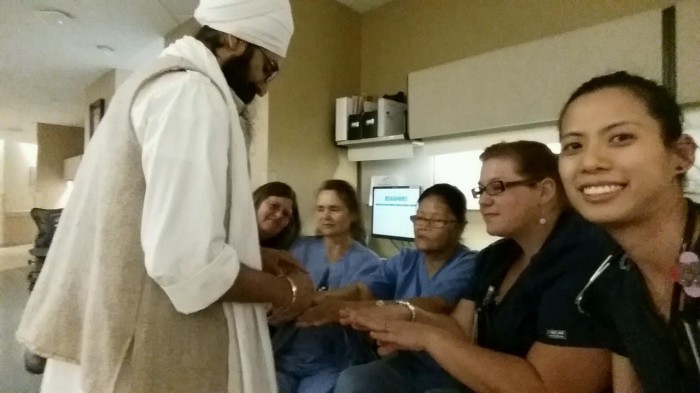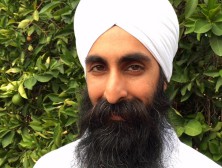The Sikh Chaplain Part 4
 |
|
Blessings of the Hands at the hospital. SS Amar Atma Singh offered a Gurbani Tuk and translated it for them as they received the blessing. |
As a chaplain at the hospital I am given the privilege to visit anyone from any faith. This is not to say that I go in and preach my religion or my beliefs. Rather the purpose is to support the quest of one's own meaning and purpose in their life, to help them discover in their own terms their place in this cosmic play. In doing so I take the guidance of Guru Nanak,
Suni-ai Dukh Paap Kaa Naas
By listening, pain and errors are erased
I listen, I'm present, I am with them in their crisis. I am a companion of their soul, on a journey with them in their own discovery. It is not about being religiously right or theological or philosophically debating... It is to be with the heart and that is why they say 'Chaplains learn the art to be with the heart.'
With all that being said and briefly sharing about what inspires me, it is my very humble honor to announce that as I am now in the final stages of my 1600 hours of training, I have been offered a full-time paid position as a Staff Chaplain at the hospital I have been training in!
Chaplains have a special calling and to do this kind of work there are skills involved as well. There's a way of how to listen, how to become companions to the soul, how to be present, how to enter a room, how to be part of the family in seconds, and very important how to leave the room. Chaplains learn how not to preach and how not to offer unsolicited advice. There are ways to listen for the clues that unlock their inner being that light the way to their discovery.
Chaplains are a special breed of people serving in this way and specialize in emotional and spiritual care. They understand that to connect to people and help them is to empathize with them, to meet people in their pain and in their struggle. They learn the subtle value of helping from being rather than from helping from doing recognizing that presence has importance. They are taught to lean into the pain and have the difficult conversations. They are taught how not to fix people or be responsible for the circumstances that takes place. That's a big one. Chaplains are guides. They hold and invoke the sacred space amidst the sterility and systems of hospital culture and procedures. They maintain a holistic view of people and advocate on their behalf to be seen not just as patients or diseases but as whole persons.
To do this work requires an extraordinary amount of introspection and self awareness, and that becomes the training ground of a Hospital Chaplain. Along with graduate level degree, they participate in 1600 hours of clinical training called Clinical Pastoral Education (CPE). Majority of their time is in clinical work, being with patients and learning under the model of process-based education.
There are two dynamics to educational process besides the clinical experience: Assessment and Formation. Classes are held in small group format training together as a cohort, where case presentations and didactics are used to develop skill sets for Spiritual Care Assessments- an interdisciplinary approach to understand the elements of suffering and what Spiritual Care Interventions can be used to better serve those in need.
As Chaplains in training we look for the blind spots in our being, the areas in our life that are unconscious to us or places where we have unresolved emotional and spiritual pain. We reflect immensely on them, as these blind spots hinder our ability to truly be with people in their pain. It is said that you can't sit with people in the dark spaces of their lives if you haven't sat in dark places of your life first. This component reflects the "formation" that takes place in CPE, the deepening of a Chaplain's emotional intelligence and capacity to empathize through self-awareness and introspection.
The goal of a Chaplain is to become Board Certified in Chaplaincy. Along with the 1600 hours of CPE, they complete 2000 hours of provisional hours as a working and employed Chaplain whether in a hospital, nursing home, long-term care facility, or hospice. Before sitting before a committee for Board Certification, the Chaplain demonstrates expertise in 29 areas of Competencies of Spiritual Care. The full journey of a Board Certified Chaplain is at least 6 years of training. They must be ordained as a Minister of their faith and receive an Endorsement from the head or authority of their religion. After taking Amrit in 2009, I offered my head to the Guru once again in 2012 and took the Sikh Dharma Minister Vows to expand my relationship of becoming a Professional Minister.
Singh Sahib Amar Atma Singh Khalsa
|
SS Amar Atma Singh Khalsa is currently a Chaplain at Banner University Medical Center in Phoenix, Arizona. This series of five articles describes his journey and experience to becoming a Hospital Chaplain. Amar Atma Singh has a Master's degree in Traditional Chinese Medicine, and is a minister through Sikh Dharma International. He can be contacted at: [email protected] |
 |
----------------------------
The Doorway to Chaplaincy ~ Part II
Finding Spirit in the Trauma ~ Part III
Related Articles:

